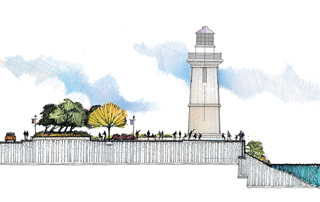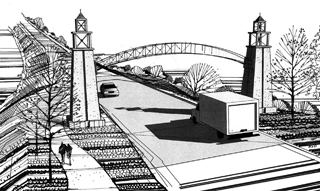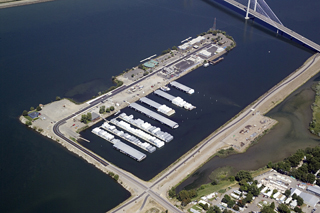
DJC.COM
November 19, 2009
Kennewick island lighthouse a beacon for downtown
HDJ Design Group

Fetterolf
|
What does a 62-foot-tall lighthouse on the Columbia River have to do with shoreline restoration?
It’s a figurative and literal beacon that will draw attention to the long-neglected Clover Island. Increased community focus on the Columbia River island will drive redevelopment interests, and with it, the revenues necessary to fund a shoreline cleanup.
Located just north of historic downtown Kennewick, Clover Island is situated to become the beacon of the community, setting the standard for future redevelopment of the area.
The 17-acre island is currently home to a U.S. Coast Guard station and several businesses, including a hotel, two restaurants, office buildings and a newly reconstructed marina. Yet over the past 70 years its shorelines have been used as a dumping ground for concrete trucks and construction debris.

Images courtesy of HDJ Design Group
The 62-foot-tall lighthouse will include a small pedestrian plaza with a seating wall that offers sweeping views of the Columbia River. Local officials hope the project will help draw visitors to downtown Kennewick. |
The Port of Kennewick saw the gem beneath the debris and wanted to capitalize on the island’s cultural, historical and recreational potential. The intent of the project is to create a heightened and memorable “shoreline experience” for tourists, the surrounding community, businesses and recreational users that visit the island.
The port began the first phase of the shoreline restoration project in September. This phase involves construction of a 26-foot-tall, 63-foot-wide gateway feature that will welcome visitors to Clover Island and to historic downtown Kennewick. Finished with natural stone and galvanized steel, with subtle LED-reflected lighting under the archway, it will be eclipsed only by the lighthouse.
Soon-to-be landmarks
The lighthouse is the central feature of this improvement project, and when completed it will be the only fully functioning lighthouse on the Columbia River.
Once constructed, the Coast Guard plans to name the structure a PATON (private aid to navigation) and will include it on their navigational charts, serving to help boaters determine their location and safely navigate the Columbia River channel. Rather than use a powerful rotating searchlight, the lighthouse will use a solar powered LED light, donated by the Coast Guard, which will flash approximately every four seconds — similar to a dock light.
The main lighthouse structure will be made in four quarter-circle precast concrete panel sections. Each panel will be lifted separately and set into place on the foundation. The top structure will be prefabricated and lifted into place as a single completed section.

A gateway will welcome visitors to Clover Island and Kennewick’s historic downtown. |
The lighthouse will stand almost as tall as a six-story building and measure 20 feet across at its base. The view from the top stretches downriver past the landmark Ed Hendler Memorial Bridge (cable bridge) to the distant Blue Mountains and upriver past the Pioneer Memorial Bridge (blue bridge) to Rattlesnake Mountain.
At the base of the lighthouse will be a small pedestrian plaza. This plaza will serve as a gathering place and viewing area for people using the future shoreline path system on the island.
This plaza will be landscaped and feature colored, stamped, desert-tone concrete in a circular pattern emanating from the lighthouse. The plaza will also provide a seating wall at the island’s west end, providing visitors with spectacular views of the Columbia River.
“We’re looking forward to the lighthouse and welcoming arch becoming Tri-City landmarks as Clover Island continues to evolve,” writes the Tri-City Herald editorial board. “Port commissioners, staff and designers have put a lot of thought and effort into making the island a community showcase. It’s not hard to imagine the next iconic image of the Tri-Cities incorporating the lighthouse and the cable bridge.”
Shoreline cleanup
In the second phase of the shoreline cleanup project, the westerly slope of the causeway that connects the lighthouse and the gateway feature will be addressed.
Over many years, the slope has been used by many people to dump concrete and asphalt from demolition projects as well as a location to washout unused cement from cement trucks. As time went by the island’s sandy soil has eroded out from under this waste concrete, creating unsightly and unsafe concrete plumes that now overhang the river.
HDJ and the port have been working with the National Marine Fisheries Service, Washington State Department of Ecology, the Army Corps of Engineers, and the Washington State Department of Fish and Wildlife to develop a new, more environmentally friendly shoreline. The new shoreline will have many varied elements to it, including shallow banks, terrain variation, large tree trunks with attached root wads, large and small boulders.
Concrete will be removed or broken up and used as fill material. Asphalt and other harmful materials will be disposed of at a facility designed to accept the material.
The banks above the water line will be reshaped and planted with native varieties of plants. The bank will also have a walking path incorporated into it that will invite people to walk along the shoreline area and view the wildlife that will be drawn into the area from the newly created habitat.
Changing a wasteland of solid concrete into a diverse ecosystem that is inviting not only to animals but to humans is a goal the port has been striving to achieve.
Development catalyst
The dividends of this shoreline improvement will spread throughout the entire Tri-City area. The project will play a huge role in bringing people to Kennewick’s historic downtown, says Tim Arntzen, Port of Kennewick’s executive director.

Clover Island is home to hotels, offices and restaurants, but it’s been a dumping ground for concrete and construction debris. |
“With more people visiting, they will spend money and entice new business development,” he says. “This is the reason the port is making such bold investments on its waterfront. It’s about urban revitalization, and helping transition a core downtown neighborhood.”
Future phases have the port focusing on a 28-acre section of shoreline property adjacent to the island. The goal is to transform that area into an active, mixed-use development.
The port has already purchased 14 acres within this blighted commercial neighborhood and envisions the area redeveloped as a mixed-use waterfront destination. The vision for this area include an IMAX theater, gondola, carousel, restaurants, public plaza, pathways, and riverfront restaurants and buildings with a mix of commercial, retail and residential, overlooking an existing urban wildlife area.
Visit the port’s Web site at http://www.portofkennewick.org to see the Columbia Drive Conceptual Plan.
John Fetterolf is the Pasco branch manager for HDJ Design Group and is the project manager for the Clover Island shoreline project.
Other Stories:
- Bellingham embarking on ambitious waterfront plan
- Magnolia Bridge complicates pier project
- Placid park belies a major engineering effort
- 21st-century waterfronts: What makes them work?
- Bellevue reconnecting with its waterfront
- Planning a shoreline project? Win over the public first
Copyright ©2009 Seattle Daily Journal and DJC.COM.
Comments? Questions? Contact us.